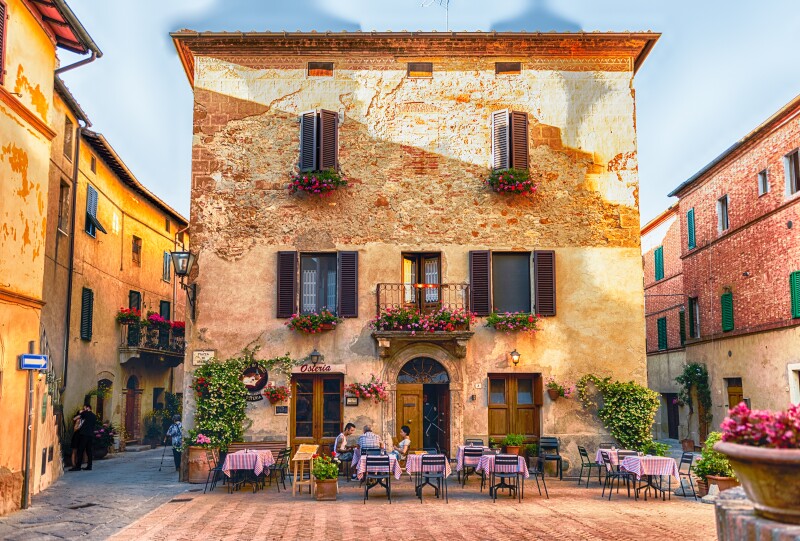In recent years, communities across Europe have been looking for ways to combat problems with overtourism and make cities more livable for residents. Some cities, such as Manchester and Venice, have implemented tourism taxes, while others, like Amsterdam and Majorca, a Spanish island, are limiting or banning large cruise ships in the city center.
But there are other ways to encourage visitors to get off the well-worn tourist path. This spring and summer, a trio of new hiking trails—the Cammino Retico and the Sentiero dell’Arte e dell’Anima in Italy and the Palmihar in Portugal—has opened, intending to expand tourism into the countryside and lessen the burden on Europe’s big cities.
Here’s what you need to know about the new trails—and how you can experience them firsthand.
Italy’s Cammino Retico
Stretching 105 miles through the Dolomites, Cammino Retico, which opened in May, connects 10 remote mountain villages in the Veneto and Trentino regions of northeastern Italy. Named for the pre-Roman Raeti people who once lived here, the circular route starts and ends in Aune di Sovramonte, near the city of Belluno.
Along the way, the route crosses through plateaus and valleys and passes by mountain villages and alpine lakes.
“It mainly passes through areas that are not very populated and urbanized,” said Francesco De Bortoli, who came up with the idea for the Cammino Retico. “You can walk for hours without meeting anyone.”
Along the way, hikers can stop at various sites of historical interest, including Monte Avena, where traces of Neanderthal populations have been discovered, and the Sanctuary of Saints Vittore and Corona, a 12th-century Byzantine-Romanesque church with original frescos. The trail also passes by the Pedavena Brewery, which has been operating since 1897, and a bicycle museum in Cesiomaggiore.
The itinerary is designed to be completed in seven days (though hikers can extend their trip, staying longer in some of the towns and completing side hikes). Along the way, trekkers can overnight at more than 50 accommodations, such as Villa San Liberale, dating back to the 1700s in the walled city of Feltre, and Campo di Cielo, a farm stay in Cesiomaggiore that offers panoramic views of the Feltrina Valley. Camping along the way also is possible.
Since the trail’s opening, more than 200 travelers have completed the entire hike, De Bortoli said.
A second route specifically for mountain bikers, called the Rhaetian Way, is expected to be completed in 2025.

The Sentiero dell’Arte e dell’Anima begins in the ancient Tuscan village of Pienza.
Marco Rubino/Shutterstock
Italy’s Sentiero dell’Arte e dell’Anima
Translating to the path of art and soul, the Sentiero dell’Arte e dell’Anima begins in the Tuscan town of Pienza, roughly 71 miles southeast of Florence, and is meant to take visitors into the countryside.
Unveiled in March, the two-mile trail starts in the town’s main piazza and is lined with 28 marble benches. Each bench was carved by a different internationally known sculpture artist, including Mauro Berrettini and Matthew Spender.
According to Fondazione FUR, a foundation started by Urs Rechsteiner, a Swiss art collector who lives in the area who donated the benches, each artist “interpreted the theme of the seat, the bench, the space to stop and reflect or to stop and aim. Each of the great artists has given his unique contribution to the vision and interpretation of beauty and for the first time, all together, they are in one great collection and in a unique place in the world.”
Some of the seats look like abstract thrones; others look like river stones. One evokes a boxcar, while another looks like a figurehead on the bow of a ship. All allow hikers to rest and soak in the landscape of Tuscany, including vineyards, farmhouses, forests, and a former watchtower.

The Palmilhar Portugal trail will eventually extend into the scenic Alentejo region of Portugal.
PIXEL to the PEOPLE/Shutterstock
Palmilhar Portugal
When Portugal’s newest trail, Palmilhar Portugal—which translates to “Walking Portugal"—fully opens, it will be the world’s longest circular hiking route, at almost 2,000 miles. For context, that’s just slightly shorter than the Appalachian Trail, the point-to-point route that runs between Georgia and Maine.
For now, only the first section has opened for hikers and bikers in Alenquer, just north of Lisbon. Another 15 sections are anticipated to be completed by the end of 2024.
Ricardo Bernardes, the founder of the project, estimates the trail will be completed in about three years. It will pass along Portugal’s northern and southern borders, with vineyards, towns, national parks, and coastline along the way.
In the coming months, travelers who tackle the route can track their progress on a mobile app, including a digital passport for recording each section they’ve completed. There will also be a physical passport that can be stamped, a concept that is used on the famed Camino de Santiago pilgrimage in Spain.








